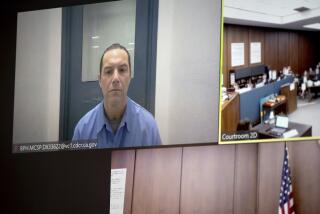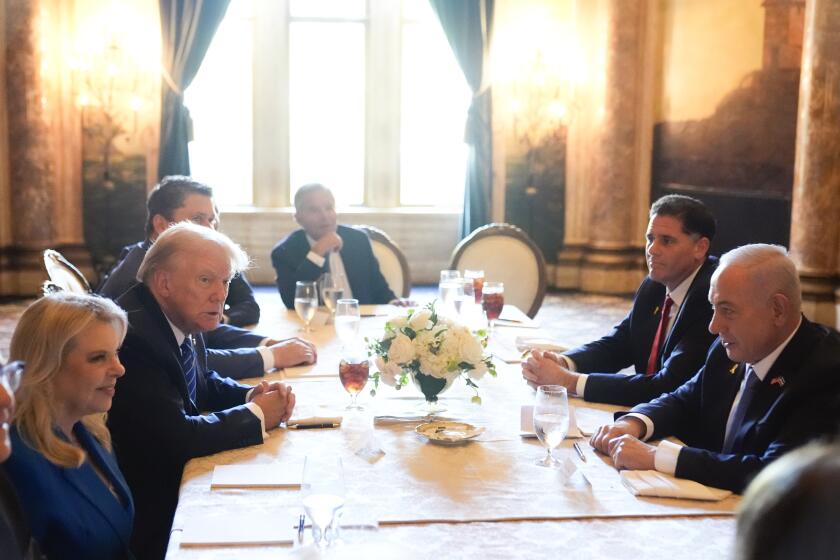New DNA Evidence in Simpson Case
Shifting to the second wave of their DNA evidence, prosecutors in the O.J. Simpson murder trial called another scientist to the witness stand Tuesday, this one to tell the jury about tests performed by the state Department of Justice and, government lawyers say, to help seal Simpson’s fate.
The witness, veteran analyst Gary Sims, spent most of the day laying the groundwork for the introduction of the next batch of results, telling the jury about his credentials and about the results of proficiency tests given to him and his colleagues at the Justice Department’s Berkeley lab. Near the end of the session, Sims began describing the actual results produced by him and by his lab.
The results presented Tuesday included the first evidence that blood consistent with that of both victims, Ronald Lyle Goldman and Nicole Brown Simpson, was found on a glove that police say was discovered behind a guest house at Simpson’s Brentwood estate. At least one stain on the same glove, prosecutors have said, includes blood consistent with that of Simpson.
Jurors, by now familiar with the smeared X-rays that depict the banding pattern of genetic markers in DNA, stared again Tuesday afternoon at the large screen above the witness stand as Sims described various batches of tests that he performed last summer and fall.
One at a time, the various test results mounted Tuesday: Four stains on the glove were consistent with that of the blood of the victims; one stain from a sock in Simpson’s bedroom visually matched the genetic markers of Nicole Simpson.
“When you saw this . . . what opinion did you reach with respect to the consistency between Nicole Brown and the sock stain?” Deputy Dist. Atty. Rockne Harmon asked the witness Tuesday afternoon as the jury and the rest of the courtroom gazed upward at the X-ray.
“I reached the conclusion that there was a visual match,” Sims responded.
And more results are still to come. All told, scores of samples were subjected to DNA analysis in the Simpson case--an enormous number of samples that prosecutors and DNA experts say may exceed that of any previous case in American history.
Despite the DNA evidence, Simpson has pleaded not guilty to the June 12 murders of his ex-wife and her friend. His lawyers have mounted a wide-ranging challenge to the DNA evidence in the case, accusing police of sloppy procedures, accusing one lab of incorrectly interpreting the statistical significance of DNA “matches” and arguing that the DNA results are irrelevant because they are based on tests conducted on tainted--and possibly planted--items of evidence.
The defense challenge is a high-stakes one, given the enormous statistical significance that prosecution witnesses say comes with the DNA results.
Last week, Cellmark Diagnostics laboratory director Robin Cotton testified that her lab concluded that only one in 6.8 billion people had genetic markers found in Nicole Simpson’s blood and that those markers were evident on a sock discovered in her ex-husband’s bedroom the day after she was murdered. On Tuesday, Sims said his tests also pointed to Nicole Simpson as a possible source of that blood.
“I reached the conclusion that there was a visual match” between the blood on the socks and Nicole Simpson’s blood, Sims said. O.J. Simpson, the analyst added, could not have been the source of that blood.
Sims did not say what his computation of the statistical significance of that or other results presented Tuesday were, but he will return to the witness stand today.
Labs Bolster Each Other
It is extremely rare for prosecutors to submit DNA samples to more than one lab for testing, but in the Simpson case, prosecutors hope the use of two labs will head off the defense’s criticisms of either lab’s procedures by allowing jurors to hear evidence that the various analysts reached the same conclusions.
In addition, the significance of DNA test results are magnified as more genetic markers are used to test a sample. The additional tests, then, greatly reduce the number of people from whom a blood drop could have come and increase the statistical significance of the DNA matches.
Because of that, the results that Sims is presenting this week help the prosecution on two fronts--by suggesting that Simpson is linked to the scene of the crime and by thwarting some opportunities for the defense to challenge the analysis.
Nevertheless, lead Simpson trial lawyer Johnnie L. Cochran Jr. cautioned against judging Simpson based on the evidence so far.
“You have to wait,” he said as he left the courthouse Tuesday. “It took until the end of Dr. Cotton’s testimony before you saw anything.”
Despite the enormous significance that both sides attach to the DNA evidence, prosecutors have introduced those results coolly and unemotionally, backed by a pair of likable witnesses.
On Tuesday, Harmon conducted his questioning in a flat monotone that drifted toward sarcasm when his examination was interrupted by the defense. But the tone of Harmon’s inquiry did not fail to catch the jury’s attention; while jurors seemed disinterested in much of Sims’ recitation of his credentials and background, by late afternoon, when he began to detail results, they snapped back to attention.
All of the panelists were taking notes and following closely as Sims scanned each of the X-rays portraying various DNA markers. As he was shown each one, Sims would identify the telltale markers with colored arrows and show the jury how he had matched them to the blood of the victims.
Blood-Splattered Socks
That testimony came near the end of a day that had begun slowly, with a long recitation of Sims’ educational background and with a primer on his history and that of his lab. That questioning did not appear to captivate jurors, some of whom whispered comments to one another.
But just before the lunch break, Sims offered his first tidbit to the jury about the analysis he performed in the Simpson case.
Standing directly in front of the jury box and gesturing to a slide of two socks found in Simpson’s bedroom, Sims told the jurors that bloodstains on them indicated that they were splattered on the inside and outside of both legs and that there were more than a dozen droplets, some large, some very small.
The stains also included a number of microscopically small flakes and spots, Sims added, details that could undermine the defense’s contention that a police officer stained the socks with Nicole Simpson’s blood while they were in the care of the LAPD. Tampering such as that would be unlikely to produce splatters, authorities say.
In addition, Harmon elicited Sims’ testimony that the bloodstains on the socks had not soaked through to the opposite side of the cloth. That suggests that the socks were not lying flat when they were splattered with the blood but rather that something prevented the blood from soaking from one side of the garments to the other side. Prosecutors, of course, maintain that it was Simpson’s leg and that the blood was splattered on the socks as he struggled with Goldman or strode away from the bodies of the victims.
Trying to bolster their argument that police planted the blood on the socks, the defense has made much of the fact that evidence-collectors did not report seeing blood on the items when they were first collected from Simpson’s house on the day after the killings. Sims said, however, that the bloodstains were difficult to see because the socks are black, making it difficult to pick out the dried blood.
“The thing that’s interesting about these socks [is] the more time you spend looking at them . . . you really do see a lot of stains on there,” said Sims, who testified in a cheery, husky voice all day. “There’s a large number of small stains.”
Defense attorneys also have said they will support their conspiracy theory by showing that blood on the socks in Simpson’s bedroom contains traces of a preservative placed into test tubes with blood samples. If true, that could suggest that the blood of Nicole Simpson was placed on the socks after it was drawn from her body.
Prosecutors vehemently deny that the traces of the preservative found on the socks support the defense’s contention. The preservative does exist in other products aside from blood vials, and an FBI analyst concluded that the amount discovered on the socks was not significant. Simpson’s lawyers disagree.
“The socks will be hotly contested,” Cochran said. “There will be a lot of vigorous testing with regard to the socks and how the blood got in the socks.”
Questions About Mistakes
The results highlighted Sims’ testimony, but Harmon also used his questioning to head off the various lines of attack that the defense so far has pursued in the case.
On Monday, for instance, defense attorney Peter Neufeld peppered Cellmark Diagnostics director Cotton with questions about her lab’s proficiency in light of mistakes it made on two sets of tests in the late 1980s. Two Cellmark errors on those tests, Neufeld suggested, should undermine the jury’s faith in the results that the lab reported in the Simpson case.
Anticipating similar questions about the Justice Department’s history, Harmon elicited Sims’ testimony about his own performance on proficiency tests. Sims, who said he went to work for the Berkeley lab in early 1990, testified that he had taken five such proficiency exams.
“Have you ever made a mistake on any of those [tests]?” Harmon asked, referring to the five proficiency tests that Sims said he had undergone.
“No,” Sims answered. “I haven’t.”
After Sims acknowledged that he was, of course, capable of making mistakes, Harmon posed a sarcastic question that anticipated another potential defense challenge to those test results.
“Do you try any harder on these because they are mock cases than you do on a real case where life and liberty is at stake?” asked Harmon, who has ridiculed Simpson’s defense for months.
“No,” Sims responded again. “I certainly don’t.”
Sims said all his colleagues at the state lab also have perfect records on the proficiency tests. “The latest summary that I have on that,” he said, “is that . . . the case workers have now tested something like 135 samples with no mistakes.”
Harmon Angers Defense
Harmon, a longtime foe of Simpson’s leading DNA lawyers, Barry Scheck and Peter Neufeld, is the prosecutor most despised by the DNA legal experts on Simpson’s defense team, which has asked Judge Lance A. Ito to sanction the government lawyer for misconduct.
But while Harmon has long put pressure on the defense team outside the jury’s presence, Tuesday marked his first handling of a witness.
Predictably, his questioning drew frequent objections from Scheck, whose shaggy hair and New York accent are a striking contrast to Harmon’s ramrod straight posture and craggy combativeness. For his part, Harmon seemed to delight in pushing the limits of his questioning and in irritating his counterparts.
Through the day, the prosecutor posed questions that suggested the defense had obtained its own set of blood samples for testing. Although that is true, the prosecution is not allowed to comment about defense testing, and Simpson’s team is not obligated to introduce any of its results.
Outside the jury’s presence, however, Harmon repeatedly has asserted that the defense has conducted its own tests and that they have failed to bolster Simpson’s case. On Tuesday, he hinted at that by eliciting the analyst’s testimony that he had split samples with Edward Blake, one of the country’s foremost DNA experts, who has been retained by the defense.
Blake has said that he does not expect to testify in the Simpson trial, and prosecutors say that is because his observations would not help the defense. Believing that, Harmon worked Blake’s name into question after question Tuesday, presumably to raise the jury’s suspicions if the scientist is not called to the stand by Simpson’s lawyers.
Although Blake was not identified as a defense expert Tuesday, Scheck steamed at the line of questioning about his own expert and about the splitting of the samples.
“Enough is enough,” he said at one point when the jury was out of the courtroom. “He really went over the line there.”
Far from apologetic, Harmon pressed ahead. When Ito suggested that the prosecutor did not need to respond to Scheck’s comments, Harmon decided to respond anyway.
“There is always a necessary response to Mr. Scheck,” Harmon said. “You know, how much longer do we have to pretend that those requests for splits were sincere. . . .”
But as Harmon prepared to launch another attack on the defense, Ito cut him off. Instead, the judge ordered Harmon to steer clear of the topic in front of the jury--an admonition that the prosecutor obeyed for the rest of the day.
The Simpson trial resumes this morning with Sims expected back on the stand and Harmon continuing to pose questions. Under prosecution questioning, Sims is expected to detail more DNA test results, including samples taken from Simpson’s Ford Bronco, the link that is so far missing from the prosecution’s so-called “trail of blood” connecting the scene of the crimes to Simpson’s estate.
More to Read
Sign up for Essential California
The most important California stories and recommendations in your inbox every morning.
You may occasionally receive promotional content from the Los Angeles Times.







